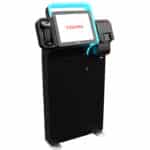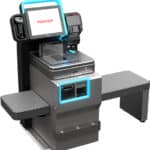
Grocery Self Checkout & Accessibility
by Food Institute. Includes comments from Toshiba, Storm Interface and also Kiosk Association. One distinction that we like to make is that self-checkout at grocery stores is closely aligned with Point
of Sale terminals and in fact are truly just hybrid customer-facing POS terminals or platforms. You can see on the Toshiba site how they categorize their self-service offerings with three iterations one of which is what we call a standup kiosk. The “warts” which are the POS terminals attached to these are almost always the complicating factor. Money transfers have that effect. We are impressed with Toshiba responding. You might think NCR would respond but probably they have their hands full right now in the middle of their reorganization of retail and financial divisions (the financial division being
banks and ATMs generally). Related article from WSJ.
Excerpt
Unequal access to privacy
From a consumer perspective, the merits of a self-checkout lane are speed and privacy. During the 2018 lawsuit, Walmart maintained that its self-checkout system is accessible because staff are trained to help. But if disabled customers have to ask for assistance, not only will the transaction likely take longer, they also lose the option to keep their purchases private.
“When it comes to the self-service checkouts in retail stores, we all understand that there are certain items we might want to purchase which are of a personal nature,” said Nicky Shaw, U.S. operations manager at Storm Interface, a company that creates assistive technology products used at both Taco Bell and McDonald’s, in an interview with The Food Institute.
“Having the option to check out independently is unfortunately not available to all customers because of inaccessible POS,” Shaw explained. “By denying some customers this option, what message is the retailer sending to those customers?”
Meanwhile, self-checkout has only become more ubiquitous in the last few years. In 2018, self-checkout represented 18% of all grocery store transactions. By 2021, when the Walmart ruling came to pass, that figure had increased to 30%, according to FMI.
Walmart, Kroger, Dollar General and Albertsons are all piloting stores that consist entirely of self-checkout lanes.
“Having the option to check out independently is unfortunately not available to all customers because of inaccessible POS. By denying some customers this option, what message is the retailer sending to those customers?” -Nicky Shaw, U.S. operations manager at Storm Interface
From Toshiba — The U.S. Access Board’s proposal is already supported by the NFB and the National Association of the Deaf. If an agency with enforcement powers adopts the new guidelines, the proposed regulations could become official rules, changing the standards that retailers and self-checkout manufacturers must comply with.
“Our self-checkout systems and their components such as payment device location, touch screen, scanner location and bag racks are designed to meet or exceed industry guidelines for accessibility,” said Dan Kelaher, senior human factors engineer at Toshiba Global Commerce Solutions.
But ensuring that self-checkout machines are actually accessible once they’re placed in a store requires close collaboration between manufacturer and retailer.
“Retailers must also follow building guidelines and requirements to ensure adequate space is provided around the self-checkout system so all individuals can access and use all the available features,” Kelaher said.
More Posts
- Grocery Stores Checkout – Writeup & Opinion (low) on WSJ formula installment
- How Popular is Self-Checkout at Supermarkets(Opens in a new browser tab)
- Why some shoppers steal at self-checkout(Opens in a new browser tab)
- You’re Going To Use That Self-Checkout Machine Whether You Like It Or Not(Opens in a new browser tab)
Another article on Food Institute the kiosk association contributed to is their article Cybersecurity and the Food Industry
Excerpt:
“You play in a muddy pond, you are going to get muddy,” said Craig Keefner, executive director of the self-service and kiosk association, and a leader in QSR, fast casual, point-of-sale, and kiosk operations, to The Food Institute.
“Home and corporate are different environments, and the usual caveats and cautions always apply. Maintain focus on outside third-party vendors and suppliers that access your commerce and ordering platform,” describing a situation at Target when a vendor logged into the supply chain software using free malware that hadn’t been updated. A virus spread across the primary domain controllers, disrupting business and prompting a massive internal audit of security actions and procedures.
“The usual complaint about IT is that they are never 100% happy until no one can access your network,” he added, “and the increased number of remote workers logging into corporate systems are yet another danger (much like third-party vendors accessing your corporate system).”
— Ironically a few days after this article another article came out on MuddyWaters and how they hack corporate mail — that was Bleeping Computer
Comments
- So given the reasons to not use self-checkout at grocery, why is it flourishing?
- The biggest reason companies are deploying Self-Checkout now is that they cannot get enough employees to run their stores. COVID helped move the trend further, but retailers must do more with less. There are 3 million fewer retail workers than we had pre-COVID, but 10,000 new stores. So self-checkout helps retailers move employees to other functions like Click and Collect, preparing meals, and picking digital orders. This is just one technology of many that retailers are deploying to help redeploy labor and lower costs. — Greg Buzek of IHL Services






